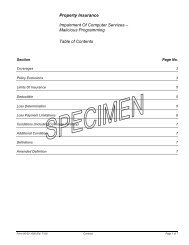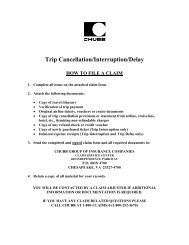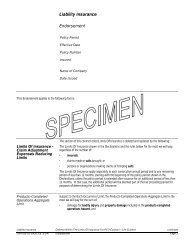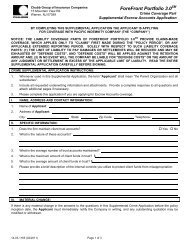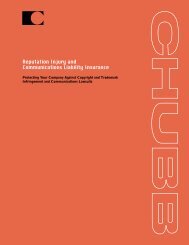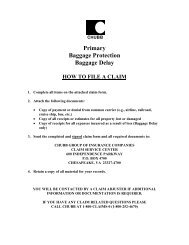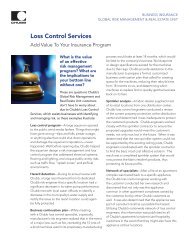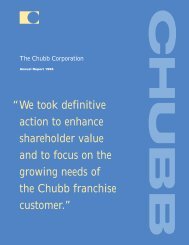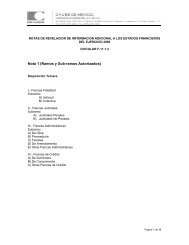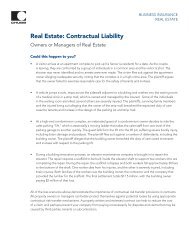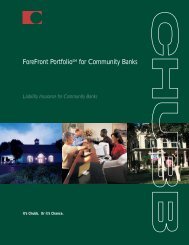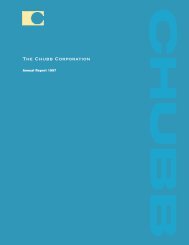Annual Report 2005 - Chubb Group of Insurance Companies
Annual Report 2005 - Chubb Group of Insurance Companies
Annual Report 2005 - Chubb Group of Insurance Companies
Create successful ePaper yourself
Turn your PDF publications into a flip-book with our unique Google optimized e-Paper software.
that is <strong>of</strong> value to the insured. The P&C <strong>Group</strong> continues to work closely with its customers and to<br />
reinforce with them the stability, expertise and added value the P&C <strong>Group</strong> provides.<br />
There are approximately 3,100 property and casualty insurance companies in the United States<br />
operating independently or in groups and no single company or group is dominant. The relatively<br />
large size and underwriting capacity <strong>of</strong> the P&C <strong>Group</strong> provide opportunities not available to smaller<br />
companies.<br />
Regulation and Premium Rates<br />
<strong>Chubb</strong> is a holding company with subsidiaries primarily engaged in the property and casualty<br />
insurance business and is therefore subject to regulation by certain states as an insurance holding<br />
company. All states have enacted legislation that regulates insurance holding company systems such as<br />
the Corporation. This legislation generally provides that each insurance company in the system is<br />
required to register with the department <strong>of</strong> insurance <strong>of</strong> its state <strong>of</strong> domicile and furnish information<br />
concerning the operations <strong>of</strong> companies within the holding company system that may materially aÅect<br />
the operations, management or Ñnancial condition <strong>of</strong> the insurers within the system. All transactions<br />
within a holding company system aÅecting insurers must be fair and equitable. Notice to the insurance<br />
commissioners is required prior to the consummation <strong>of</strong> transactions aÅecting the ownership or<br />
control <strong>of</strong> an insurer and <strong>of</strong> certain material transactions between an insurer and any person in its<br />
holding company system and, in addition, certain <strong>of</strong> such transactions cannot be consummated without<br />
the commissioners' prior approval.<br />
<strong>Companies</strong> within the P&C <strong>Group</strong> are subject to regulation and supervision in the respective<br />
states in which they do business. In general, such regulation is designed to protect the interests <strong>of</strong><br />
policyholders, and not necessarily the interests <strong>of</strong> insurers, their shareholders and other investors. The<br />
extent <strong>of</strong> such regulation varies but generally has its source in statutes that delegate regulatory,<br />
supervisory and administrative powers to a department <strong>of</strong> insurance. The regulation, supervision and<br />
administration relate, among other things, to: the standards <strong>of</strong> solvency that must be met and<br />
maintained; the licensing <strong>of</strong> insurers and their agents; restrictions on insurance policy terminations;<br />
unfair trade practices; the nature <strong>of</strong> and limitations on investments; premium rates; restrictions on the<br />
size <strong>of</strong> risks that may be insured under a single policy; deposits <strong>of</strong> securities for the beneÑt <strong>of</strong><br />
policyholders; approval <strong>of</strong> policy forms; periodic examinations <strong>of</strong> the aÅairs <strong>of</strong> insurance companies;<br />
annual and other reports required to be Ñled on the Ñnancial condition <strong>of</strong> companies or for other<br />
purposes; limitations on dividends to policyholders and shareholders; and the adequacy <strong>of</strong> provisions<br />
for unearned premiums, unpaid losses and loss adjustment expenses, both reported and unreported,<br />
and other liabilities.<br />
The extent <strong>of</strong> insurance regulation on business outside the United States varies signiÑcantly<br />
among the countries in which the P&C <strong>Group</strong> operates. Some countries have minimal regulatory<br />
requirements, while others regulate insurers extensively. Foreign insurers in many countries are<br />
subject to greater restrictions than domestic competitors. In certain countries, the P&C <strong>Group</strong> has<br />
incorporated insurance subsidiaries locally to improve its competitive position.<br />
The National Association <strong>of</strong> <strong>Insurance</strong> Commissioners (NAIC) has a risk-based capital requirement<br />
for property and casualty insurance companies. The risk-based capital formula is used by state<br />
regulatory authorities to identify insurance companies that may be undercapitalized and that merit<br />
further regulatory attention. The formula prescribes a series <strong>of</strong> risk measurements to determine a<br />
minimum capital amount for an insurance company, based on the proÑle <strong>of</strong> the individual company.<br />
The ratio <strong>of</strong> a company's actual policyholders' surplus to its minimum capital requirement will<br />
determine whether any state regulatory action is required. At December 31, <strong>2005</strong>, each member <strong>of</strong> the<br />
P&C <strong>Group</strong> had more than suÇcient capital to meet the risk-based capital requirement. The NAIC<br />
periodically reviews the risk-based capital formula and changes to the formula could be considered in<br />
the future.<br />
Regulatory requirements applying to premium rates vary from state to state, but generally provide<br />
that rates not be ""excessive, inadequate or unfairly discriminatory.'' In many states, these regulatory<br />
10



